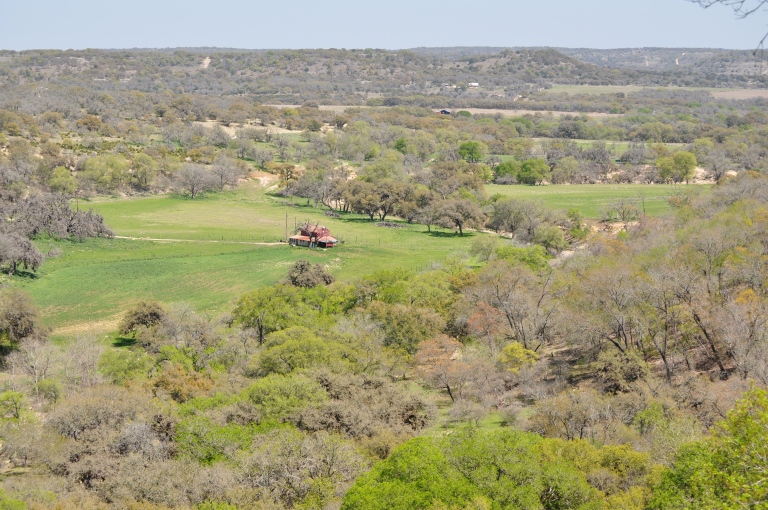Share in my adventurous journey of finding the plants that are rare and endangered and creating their portraits. The biggest challenge is not only locating their natural or protected habitat and coordinating with people that can lead you to their sites, but to time your visit to capture the plant’s bloom. If possible, I return many times so that I can record the cycle of growth through to its seed production as well. It is illegal to remove the plants or any parts, so all documentation must be done on site and there is careful monitoring! Meet these people who take time out of their busy schedule to lead an artist to a solo plant; I hope my art measures up to their dedication to conservation!
Argythamnia aphoroides Mull. Arg. , Hill Country Wild Mercury or Hill Country silverbush, Family: Euphorbiaceae, Global/State Rank: G2S2, Golobal/Slate Range: Endemic to the Edwards Plateau in Bandera, Bexar, Blanco, Brown, Comal, Gillespie ,Hays, Kendall, Mason, & Uvalde Counties
In 2010 my husband and I got juried into “Art and Conservation: Our Hidden Treasures ” for 2011; a show hosted by the Cibolo Nature Center in Boerne. This was the third year that I participated and Victor Summers joined me for this one. The purpose is to raise awareness and promote conservation of Texas Hill Country land, water, wildlife and native plants. They assign the artists to a property and our property was Jersey Springs Ranch in Comfort owned by Milby Moore. We had one year to complete our work going to the property only during specific dates with just one week for each season, March, June, November and January.
 We went out two times that spring. First visit was March 22 to meet Milby and she introduced us to her historic ranch with springs, streams, rugged cliffs and bottomland pasture. This property was a delight to explore with the eyes of both a landscape photographer and a botanical watercolorist. This gives an overview of the valley and her home.
We went out two times that spring. First visit was March 22 to meet Milby and she introduced us to her historic ranch with springs, streams, rugged cliffs and bottomland pasture. This property was a delight to explore with the eyes of both a landscape photographer and a botanical watercolorist. This gives an overview of the valley and her home.
 Many flowering trees were on the hillsides such as the Red-bud (Cercis canadensis), and the Mexican Buck-eye (Ungnadia speciosa).
Many flowering trees were on the hillsides such as the Red-bud (Cercis canadensis), and the Mexican Buck-eye (Ungnadia speciosa).
Climbing down a hill, we arrived at a grotto with the springs and lush maiden ferns.
In the canyon I stopped to draw/record the Spicebush blooming. A small tree that grows in shade on moist alluvial soil near streams and springs; easily recognized by the citrus aroma of crushed leaves that turn lemon yellow in November. We learned about the Spicebush caterpillar that uses the Spicebush as its host. It initially appears as a bird-dropping and then transforms into a brilliant, bright green “predator”or snake-like camouflage with enormous false “eyes” out of which the Spicebush Swallowtail emerges. Later in my studio I added the caterpillar, showing the spring leaves.

During our tour Milby told us about one rare plant called Hill Country Wild Mercury on her property which I said I would be very interested in seeing, especially the bloom.
She called us when it was blooming. We returned the next day on March 31st to see it and also spend more time exploring other specimens blooming such as the Fringed Puccoon (Lithospermum incisum).
 These perennials have a yellow tubular flower and have a root that not only yields a red dye but was also used medicinally.
These perennials have a yellow tubular flower and have a root that not only yields a red dye but was also used medicinally.
In just 9 days from our first visit on the Ranch there were so many more species blooming.
Other blooms caught our eye such as the Creek Plum (Prunus rivularis), Agarita (Mahonia trifoliolata) and I better draw the Mexican Buckeye flowers before it fades.

Later she drove us to the rare Hill Country Wild-Mercury.
 It is a herbaceous perennial about 20-50 cm with 10-100 unbranched stems.
It is a herbaceous perennial about 20-50 cm with 10-100 unbranched stems.
In this close-up of the plant you can see the leaves are alternate and simple densely villous with grayish silky hairs. Flowers are tiny (4-5mm) and whitish green with 5 petals. I spent the rest of the day documenting this plant.

We returned later in the fall/November to see the oaks turning red, the possumhaw trees full of berries, the spicebush with fruit & leaves turned yellow, the buckeye seeding and grasses turning golden with horses grazing.

Mixed ecosystems and the change of seasons were a delight to behold and record. Thank you Milby!
Here is our entry into the exhibition:

Learn, Give Thought, Be Inspired, Take Action……Bring Back Balance
Lotus McElfish LotusMcElfish.com
If you would like to subscribe to receive new posts of endangeredandnotsomuch by email write lotusmcelfish@mac.com














